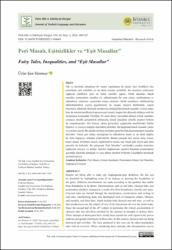| dc.contributor.author | Şen, Ürün Sönmez | |
| dc.date.accessioned | 2023-05-02T06:09:21Z | |
| dc.date.available | 2023-05-02T06:09:21Z | |
| dc.date.issued | 2022 | en_US |
| dc.identifier.citation | Sönmez, Ü. Ş. Peri Masalı, Eşitsizlikler ve “Eşit Masallar”. Türk Dili ve Edebiyatı Dergisi, 62(2), 489-527. | en_US |
| dc.identifier.issn | 1015-2091 | |
| dc.identifier.uri | https://doi.org/10.26650/TUDED2022-1104665 | |
| dc.identifier.uri | https://hdl.handle.net/20.500.12294/3806 | |
| dc.description.abstract | Despite not being able to make any singleagreed-upon definition, the tale can be described by highlighting some of its features or drawing the boundaries of the genre. Different classifications are made according to the qualities that enable these boundaries to be drawn. Denominations such as oral tales, classical tales, and postmodern taleshave emerged as a result of to draw boundaries, classify, and name. Classical tales are formed through the literalization, moralization, and writing of oral tales, transforming them into ideological texts of bourgeois culture, lifestyle, and morality, and fairy tales, which include both classical and oral tales as well as their predecessors are the subject of very lively discussions all over the world today. Since the second half of the 20th century in particular, the critical accumulation of classical tales has also been enriched by the increase in attempts to destroy them. These attempts at destruction have mostly been carried out with regard to the power relations and gender stereotypes in these tales. In this context, classical tales are being destroyed and rewritten. The texts produced in this way can be called postmodern tales with an overview. When considering these attitudes, this denomination can be criticized as being too inclusive, if not inaccurate or incomplete. In addition, definitions that reveal the intention are also used, such as anti-tales, conflicting tales, counter tales, progressive tales, tales of liberation, and equality tales. The present study analyzes the reproductions in the Esit Masallar" in the context of gender and power relations by establishing parallels with the ideological transformation of tales from the classical to the postmodern period and the critical accumulation that has been built. | en_US |
| dc.language.iso | tur | en_US |
| dc.publisher | V | en_US |
| dc.relation.ispartof | TURK DILI VE EDEBIYATI DERGISI-JOURNAL OF TURKISH LANGUAGE AND LITERATURE | en_US |
| dc.identifier.doi | 10.26650/TUDED2022-1104665 | en_US |
| dc.rights | info:eu-repo/semantics/openAccess | en_US |
| dc.subject | Fairy Tale | en_US |
| dc.subject | Brothers Grimm | en_US |
| dc.subject | Postmodern Tale | en_US |
| dc.subject | Esit Masallar | en_US |
| dc.subject | Gender | en_US |
| dc.title | Fairy Tales, Inequalities, and "Esit Masallar" | en_US |
| dc.type | article | en_US |
| dc.department | Fen-Edebiyat Fakültesi, Türk Dili ve Edebiyatı Bölümü | en_US |
| dc.authorid | 0000-0002-0893-3628 | en_US |
| dc.identifier.volume | 62 | en_US |
| dc.identifier.issue | 2 | en_US |
| dc.identifier.startpage | 489 | en_US |
| dc.identifier.endpage | 527 | en_US |
| dc.relation.publicationcategory | Makale - Uluslararası Hakemli Dergi - Kurum Öğretim Elemanı | en_US |
| dc.institutionauthor | Şen, Ürün Sönmez | |
| dc.identifier.wos | WOS:000967329100011 | en_US |


















